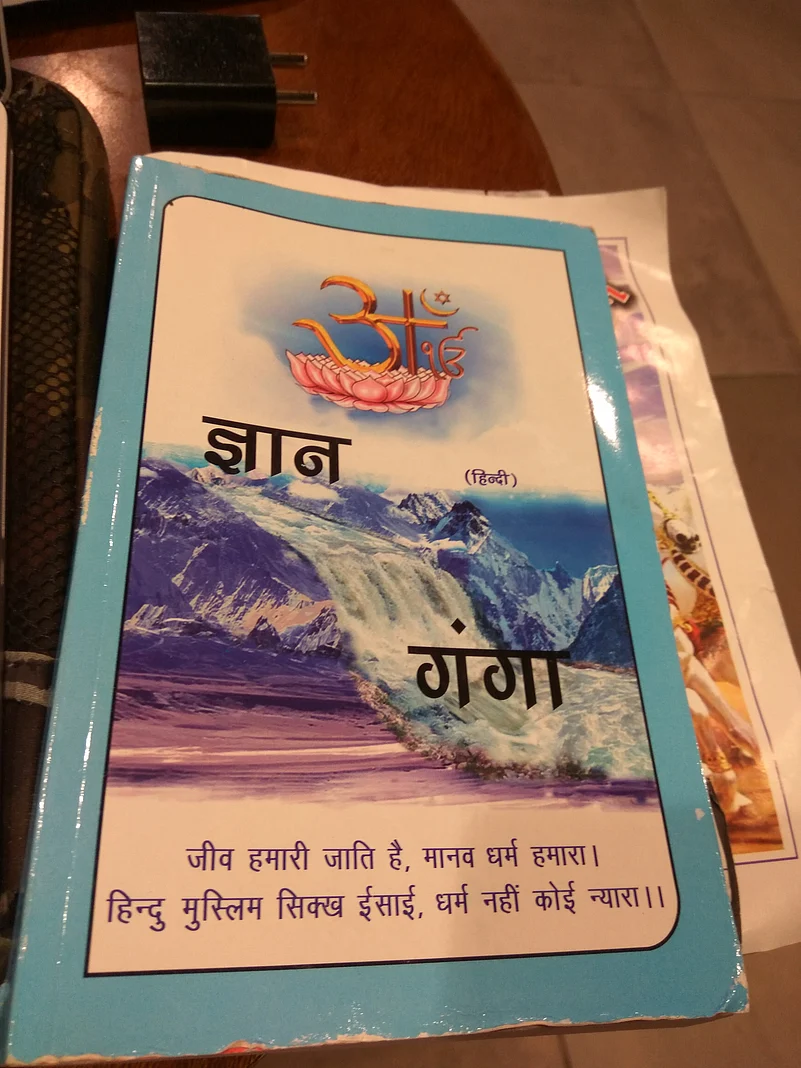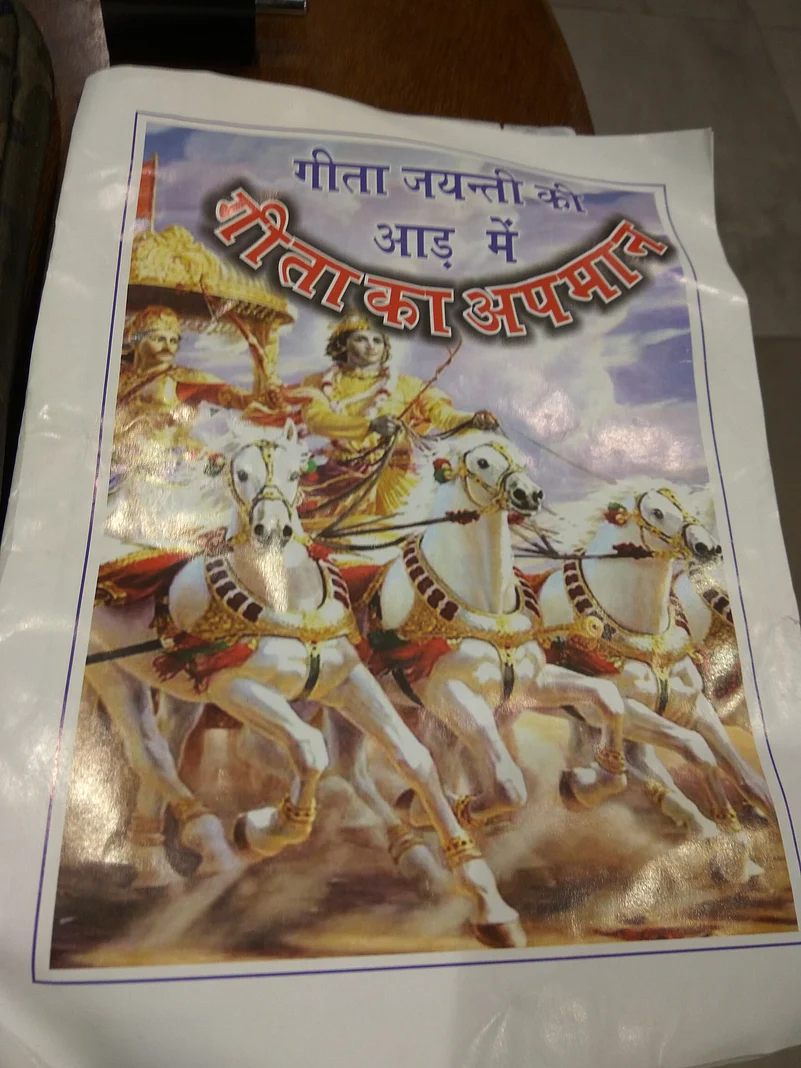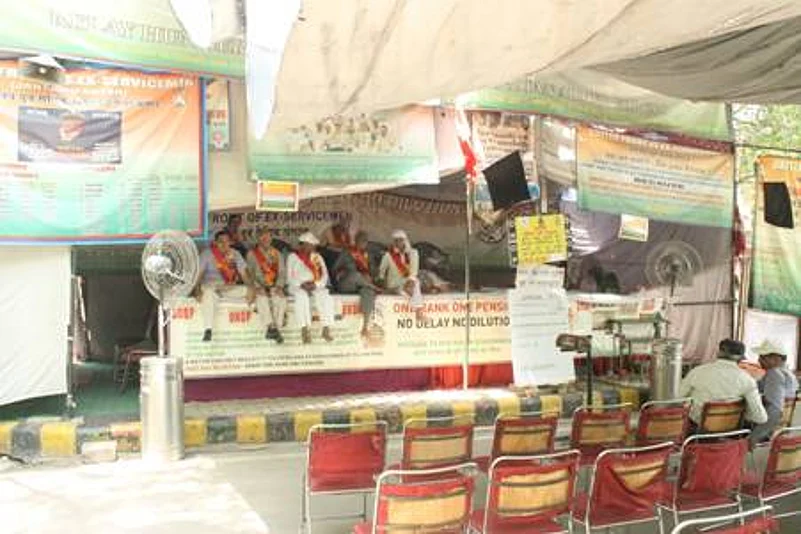On 21st May 2017, Jantar Mantar witnessed a massive Dalit protest against the recent violence perpetrated on the Dalit community in Saharanpur, Uttar Pradesh. The protesters, all sporting blue caps that said Bhim Army, were refused permission by the Delhi police to hold their rally at Jantar Mantar. However, the community took no heed of the refusal; throngs of protesters crowded the street and the air rang with cries of ‘Jai Bhim’.
This rebellious spirit, so closely tied to the idea of ‘protest’, has become a rare sight at Jantar Mantar. Everyday, the arena has approximately half a dozen scheduled protests and many more unscheduled ones. Some sit in the open while others set up stalls or sit under the shade of a tent, surrounded by bottled water, fans and clean white cushions.
Advertisement
Walking down the street seems like walking into a mela, with each stall competing with the others to garner the attention and support of the crowd. Protestors stand outside their stalls, thrusting pamphlets detailing their various causes at passersby.
As you stroll down the street, patrons of each stall try enticing you to visit their stall over others on the street. They usher you in with offers of cold water, at times even offering you hot food, if that is what it takes to capture the passerby’s attention.
Passing by a group of protesters chanting in front of a deity, this writer was handed a pamphlet that said, ‘Living being is our Race, Mankind is our Religion. Hindu, Muslim, Sikh, Christian, there is no separate Religion’.
Advertisement

The protest turned out to be in support of a Sant Rampal Ji Maharaj who, according to his followers, expounded the truth regarding the Bhagavad Gita. After listening to the story of Sant Rampal’s life, culminating in the state putting him behind bars for a controversial book he had written, I was asked if I would like to buy his book titled ‘Gyan Ganga’ for Rs. 20. A man in the crowd added his two cents, saying, “It was the best book I ever read”.

To an average spectator, this conveys the impression that protests, in recent times, lack the force they earlier embodied; instead, they feel commercialised and by extension, diluted; but it might be worth asking whether the platform of Jantar Mantar, itself, is responsible for this dilution?
In the early 1990’s, protesters could march up and down Rajpath, the road that borders the presidential palace and major government ministries built during the time of the British. “Those mass mobilisations on Rajpath were an opportunity for the people to communicate their anger directly to the government. Now, it’s no longer possible to do anything more than a symbolic protest” says local historian Sohail Hashmi.
In 1993, the Government declared Jantar Mantar the official venue to stage protests in the city. The decision was taken post the protest of Bharatiya Kisan Sangh, rumoured to have shaken the Government in 1988. “The capital had seen the biggest protest of its time. Tikait, [the leader of the protest], brought thousands of agitating farmers to the site and for almost a week he held the place under siege. He had polluted and filled the place with an army of cattle along with his protestors who even started cooking food there. A new legislation was passed and protesting at Boat Club [near Rajpath] was banned since then”, said a senior official of the New Delhi Municipal Council.
Advertisement
Another senior government leader, citing security reasons for the shift in the protest site, said, “Boat Club is just a step away from the Prime Minister’s Office as well as from the Finance, External Affairs and Home Ministries. So it was extremely unsafe to allow any such activity there”.

Protests at Rajpath, in this way, had started posing an increased threat to the government, accentuating culpability by forcing those in power to respond to protestors demands. Changing the protest site to Jantar Mantar, in turn, seems to reflect this growing anxiety among the country’s top leadership.
Jantar Mantar gave way to a more diluted form of protest, like the government wanted. To begin with, the arena restricts protester mobility, instead confining them to a stationary stall. Protesting voices can, thus, no longer march to the largest governmental bastions in the city and force leaders to heed their voices. Instead, they are expected to stay put and wait for the government to come to them, if it ever does.
Advertisement
Moreover, Jantar Mantar is just the right distance from Parliament to be close enough to convey the government’s symbolic interest in protesters demands, but is sufficiently removed so as not to disturb the daily functioning of the government.
In addition to this, protests with more than 5000 protesters are considered too large and are turned away from the street.“Where the gathering is more than 5,000, we ask them to go to Ramlila Maidan. The protesters, in most cases, do not listen to us and make it appear like we are trying to curb their fundamental right to protest. They do not understand that we can only allot a limited space as the law and order situation in the area cannot be compromised,” said a police officer in an attempt to justify this upper limit to number of protesters.
Advertisement

However, when asked, Bahadur, a plainclothes policeman who supervises over protests at Jantar Mantar, the same question—regarding what kinds of protests are disallowed at Jantar Mantar— he said, “I don’t know about the number of protesters allowed to protest at Jantar Mantar. Ask the DSP that. All we do is control the crowd if a protest gets violent”.
What has further eroded the force of protests at Jantar Mantar is the the recent farman issued by the Delhi government that restricts protests at Jantar Mantar road to seven hours, from 9 a.m to 4 p.m. Thus, protests that once went on throughout the day, with protesters going as far as to camp out in the street at night, now have to vacate the arena post4 p.m.
Advertisement
But in spite of this, there is some comfort to be derived from the fact that Jantar Mantar, though a diluted platform, is still very much a vibrant and thriving arena where the voice of the people can be heard.
This is exemplified by the recent Bhim Army protest held there that defied authoritative restrictions and compelled those in power to heed the voice of Saharanpur’s Dailt community.
The protest hub in the capital is, thus, a consistent reminder that democracy in the country, though diluted, is still alive. It might not be the best expression of the people’s voice, but it’s the best we have.



















